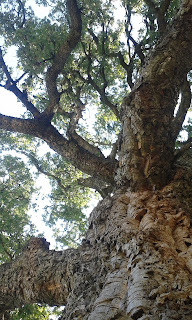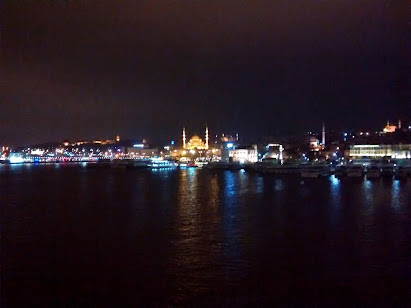Week 7 Florence to Santiago de Compostela
Monday 22nd February
By the time we have bought new boots and succumbed to an expensive note book bound in gorgeous Italian marbled paper, it is almost lunchtime but we have a long way to go, and new boots to break in.
'Don't throw away the old ones yet!'
Instead of sinking into a chair on a Florentine Piazza, we buy picnic food and set off for the coast. Tempting as it is to call in and say hello to the leaning tower of Pisa, we take the more northerly route through Lucca and Viareggio, past the marble quarries at Carrara and on to La Spezia and the Cinque Terre. Here we join the Sentiero Azzurro, the cliff path connecting the five towns with their brightly coloured houses that cling to the steep coastline.
It is getting dark by the time we reach Genoa and the new boots have done quite enough for one day. The birthplace of Christopher Columbus seems like a good place for footsore travellers to stop for the night.
'Lunch in Monaco?'
'Are you kidding? You need a mortgage for a cup of coffee.'
There are cheaper places, although not much cheaper, along the Côte D'Azur.
As soon as we cross into France we become aware of a huge black super yacht that appears to be following us along the coast.
'Film star?'
'Russian oligarch?'
'Bond villain?'
The boat is sinister and its slow progress alongside us has the menacing air of a panther preparing to pounce. Who do they think we are? Fortunately, we don't have to follow the coastline, there are good trails through the maquis, a little way inland, where the sea glints in the distance and the hill towns huddle under plane trees. Pines leave a springy carpet on the track and the cork trees, much fewer than they used to be, have beautiful, tactile bark. It is a good time to be walking here as the threat of forest fires in the summer means that these trails are often closed as soon as the weather gets too dry.We come down off the hills at Aubagne, birthplace of Marcel Pagnol, but we don't see any goats, or any authors that we recognise, nor even Jean de Florette. Marseilles sprawls along the coast, industrial and not particularly friendly so we stop short at picturesque Cassis so that we can explore the Calanques, the deep fjords that snip into the coastline between here and the Rhône.
Wednesday 24th
 The walking along this bit of coast path is as demanding as anything we've met so far but it is worthwhile. We scramble down the sides of deep gouges in the white rocks and find turquoise water lapping the beaches. It is deep water and those of us who dip a toe testify to its being very cold.
The walking along this bit of coast path is as demanding as anything we've met so far but it is worthwhile. We scramble down the sides of deep gouges in the white rocks and find turquoise water lapping the beaches. It is deep water and those of us who dip a toe testify to its being very cold.
From there we have to turn inland to pick our way around the Rhône delta, up to Arles where we call in at the Roman amphitheatre. They still hold bullfights here in the Spanish corrida style but not today.
A further detour brings us along the edge of the Camargue with its white horses, black bulls and pink flamingoes. As dusk falls, the flamingos take off and fly in formation, the black and red streaks of their broad wings a contrast so striking that they barely look like the same birds. They gather in large flocks to roost together for safety. The Camargue is also notorious for mosquitos, although perhaps less so at this time of year. Even so, it is not the place to camp.
On la Place de la Comédie in Montpellier, at the foot of the medieval town, a lone busker plays. The sound of his amplified Spanish guitar lifts over the rattle and thrum of the trams, reverberating off the tall buildings around the square. We sit under the restaurant awnings, glad of the heaters as lamplight glistened on the wet pavement listening. The guitar's voice speaks of long summer evenings, of cicadas and the smell of dust.
Thursday 25th
Today will take us almost the length of the Pyrenees so this is goodbye to the Mediterranean. It feels like a big moment. As a final farewell we take the coast road from Sète and follow the narrow isthmus between the Étang de Thau and the sea, a morning stroll along the beach, before turning inland to Narbonne.
We approach Carcassonne along the Chemin de Montlegun, the high road with a broad view across the plain, so it is only as we draw near that the turrets of the Château Comtal come into sight. As we swing downhill along the footpath which skirts the castle of the Cathars, the size and scale of the fortress walls become more awe-inspiring with every step. It was here that the papist French Albigensians besieged the Cathars in 1209, determined to wipe out these puritanical, heretical Christians who refused to accept the leadership of the established church. The Albigensians purged the people of this region of Occitanie: they destroyed the towns, stamped out the culture and the language. The last of the Cathars was burnt at the stake in 1244, screaming from the flames the Cathar prophecy that the Church of Love would be proclaimed in 1986, that it would have no fabric but only understanding.
Our walk continues through gently undulating agricultural land with glimpses of the foothills of the Pyrenees, dusted with snow, to the south. Most striking is the change in the light. It is not just that it is more cloudy but that the air feels, tastes, looks different now that we have replaced the sea with the mountains.
The elegant architecture of Tarbes reminds us that this is Gascony, from where, some way to the north of the region, D'Artagnan rode out to join the Three Musketeers. We come to the turning to Lourdes and decide to make the detour, but are disappointed by the vast acreage of barren car park and the horrid commercialism that surrounds the precincts of the shrine. A few miles further on the handsome château of Pau, more a palace than a fortress, alerts us that we must turn off into the Pyrenees and begin to climb. Some of the place names no longer have a French ring to them, and yet nor are they Spanish: Lohitzun-Oyhercq, Juxue, Ostabat-Asme. Basque is an ancient language seemingly unrelated to any other, which has survived in spite of the cultural ravages of the centuries.
A little way short of the Spanish border we stop for the night in St Jean Pied-de Port, the official beginning of the Camino Frances.
Friday 26th
Cobbled streets lead under stone arches to narrow bridges across the river where the houses hang huddled over the water. We find the Pilgrim Office and pick up our Carnet de Pélerin de Saint-Jean. It gives us a sense of a new phase in our pilgrimage. We've been to Canterbury and Jerusalem and Rome, we've looked in at Lourdes; we've enjoyed the company of our band of pilgrims; the sight of 86 of us turns heads along the roads and by-ways but here at the start of the Camino we are joining a long established pilgrimage. There is among us a slight sense of losing our independence mingled with excitement at being, for the first time, 'official'.
'Everyone ready?'
'¡Vale!'
'¡Vamonos! Let's go.'
At first the landscape is reminiscent of the Shropshire hills, we could be back in Carding Mill Valley, but the higher we get, the more vast the skies. Forested mountains rise and fall away into the distance and there is snow on the summits. Indeed, there is snow only a little way above us and when we cross into Spain at the Col de Bentarte we find ourselves in thick cloud with snow under foot. Thank goodness for the well-worn track and the distinctive and frequent blue way-markers showing the pilgrim's cockle shell. We are soon in Roncevalles where Roland, the favourite younger son of Charlemagne, held off the Moors on the French army's retreat from Spain, famously blowing his horn only when he was the last man standing, too late to summon help.We drop down into Pamplona, too early in the year for the San Fermin bull run, and roll along the edge of the plain, the mountains rising to our right this time, through Logroño to Burgos, the ancient capital of Castile. The Gothic cathedral, its twin pinnacles pointing heavenward, is a most imposing edifice to the glory of God and the Castilian rulers and the medieval city remains intact despite centuries of ever more destructive wars. From there to León is unrelenting, undulating plain, the fields fuzzed with early greenery; it must be hard going here in high summer. After a lunch pause in the city, we are glad to get back up into the mountains.
It is too early in the year for crowds of pilgrims, for which we are thankful, but those we meet are friendly and curious about our story.
'How do you cover the distances so quickly?'
'Team effort,' is the only reply we can give. They've allowed a month or more for the Camino alone.
One of the rest places, an área de descanso para peregrinos, is called Cruz de Ferro.
'Are they trying to tell us something? We're heading for Ponferrado, the iron bridge, and here's Cruz de Ferro, the iron cross.'
'We must be steely people.'
'The next albergue is at El Acebo de San Miguel, St Michael's Holly; perhaps it's not meant to be a comfortable experience.'
To prove the point, it starts to rain.
Ponferrada finds us back among the Knights Templar as we pass beneath the walls of their magnificent fortress. It's turrets and battlement seem as clichéd as a child's toy castle but it's original 12th century purpose was to protect the Camino pilgrims so those fortifications mean business.
'They were a ferocious lot, the Knights Templar, you didn't wan to get the wrong side of them.'
The next leg to Sarria provides another stiff climb and the reward of open skies and distant views. This large Galician town marks the point where pilgrims qualify for the Compostela, the Certificate of Completion for the Camino Francés so from here we meet many more pilgrims, each with their story to tell. Some are doing the Camino because they can, others, the ones who will truly qualify for the Certificate, have more spiritual reasons: devotion, thanks, atonement. We slow right down and decide to spend the night at Portomarín, a 'new' Medieval village which was moved uphill in 1960, to make way for a reservoir when the Miño river dam was built. This involved moving the more important buildings, including the 12th century church, stone by stone. Imagine.
Tomorrow: Compostela.






What a fascinating account, and journey. When we are free to do so, I'd like to do quite a lot of it for real!
ReplyDelete